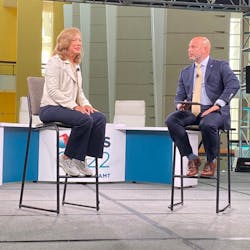IMTS Main Stage: “Glocalization” Can Bring Home Manufacturing
Mike Molnar had a simple message to convey to IMTS visitors: “Where you make it matters.”
We need to be involved in technology development as a way to have unique technology that differentiates the U.S. manufacturing, said the founding director at the Advanced Manufacturing National Program Office, the interagency team responsible for the Manufacturing USA program, who threw the first pitch on Day 3 at the IMTS Main Stage in Chicago.
In 20 years of leading advanced technology initiatives, explained Molnar, establishing collaborative research and development initiatives was a challenge. “We would work with industrial labs, universities and companies, and that wasn’t always easy,” he said.
But this is changing. Manufacturing is transforming through globalization, automation and the fourth Industrial Revolution, and the U.S. is still the leader in advanced manufacturing, Molnar said.
Something happened when the U.S. snuck into a negative trade balance with advanced technology products, he explained. “Many nations are now focusing on advanced manufacturing,” said Molnar. “Why is that? Because it is the highest economic multiplier, it is the differentiator.”
Manufacturing USA, a private-public partnership, was convened to bring together government, business, academia and other stakeholders to advance manufacturing initiatives. The beauty of Manufacturing USA is the neutrality it offers, and the manner in which it fosters ways to collaborate on game-changing technology.
If we don’t innovate where products are made, the next innovation is going to be very hard, said Molnar.
Glocalization
A similar perspective was heard on the Main Stage on Day 2, when Barbara Humpton, president and CEO of Siemens USA, described how dependence on globalization of manufacturing for finding the next incremental savings such as labor and materials on the supply side is evolving.
Digital maturity has created the opportunity instead for “glocalization,” Humpton said. “That is the idea of taking advantage of global innovation, where we’ve got a myriad of experts at Siemens working around the globe,” she said. “Now we can make a business case to actually make things local by using global designers.”
Designers may help through the animation or they’re going to show what’s possible if they create a digital twin. “The technology is making us available to producers in places all over the world,” she said. “We now have the ability to cut down on our high carbon emission societies… This is a game changer. And it's all happening at once. And that’s why I think it’s really about investors here. And it’s got the academic community talking about how do we prepare people for this. It matters how government and all stakeholders support their communities.”
For Humpton, government investment in manufacturing is just the tip of the iceberg. “What the [bipartisan CHIPS and Science Act of 2022] investment has signalled to the private sector is that they’re serious about this. And there’s one more thing: Without these dollars, a lot of international companies were really looking at other governments around the world where they are willing to offer similar packages. Whoever got there first was going to get the win.”
Investment was needed this to secure the future for the United States, she said. “Now, it takes all of us, right? Partnerships matter here.”
To this end, Siemens has been working within open ecosystems—such as its Xcelerator platform, an open, digital business platform—that is making it possible for to offer solutions to partners.
“People talk to me often about the impact of manufacturing,” Humpton said. “And manufacturers are not just thinking about the automation on the floor. They’re thinking about the building envelope. They’re thinking about the connection to the grid. We know that there’s work to be done on the grid. And we at Siemens are answering calls at every stage.”
About the Author

Rehana Begg
Editor-in-Chief, Machine Design
As Machine Design’s content lead, Rehana Begg is tasked with elevating the voice of the design and multi-disciplinary engineer in the face of digital transformation and engineering innovation. Begg has more than 24 years of editorial experience and has spent the past decade in the trenches of industrial manufacturing, focusing on new technologies, manufacturing innovation and business. Her B2B career has taken her from corporate boardrooms to plant floors and underground mining stopes, covering everything from automation & IIoT, robotics, mechanical design and additive manufacturing to plant operations, maintenance, reliability and continuous improvement. Begg holds an MBA, a Master of Journalism degree, and a BA (Hons.) in Political Science. She is committed to lifelong learning and feeds her passion for innovation in publishing, transparent science and clear communication by attending relevant conferences and seminars/workshops.
Follow Rehana Begg via the following social media handles:
X: @rehanabegg
LinkedIn: @rehanabegg and @MachineDesign

